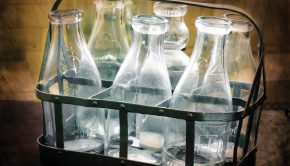Rest in Peace
Sustainable Burials Honor Life
Humans are conditioned to the conventional rituals of handling death—the embalmed body in a casket or ashes sealed in an urn, a procession of vehicles to the burial site, solemnly gathering and scattering flowers as the remains are lowered into the earth. Many times, planning details are abdicated to the judgment of funeral directors. The notion of green burials envisions something different: a ceremony that engages family members’ eco-values and nature in a more intimate, sustainable process favoring biodegradable caskets and no toxic chemicals. The movement is gaining in popularity; in 2011, some 300 U.S. funeral homes offered green burial options, up from only 12 in 2008.
High Impact of Tradition
Traditional American burial practices make a sizeable environmental footprint and also pose health risks. The carcinogenic embalming fluid—formaldehyde—is a well-known hazard. A 2009 study in the Journal of the National Cancer Institute found that exposure to formaldehyde over a career of embalming put funeral home workers at significantly increased risk for mortality from myeloid leukemia, a cancer of the blood cells. Alternatives include formaldehyde-free preservatives made from essential oils, and dry ice. Significant resources are consumed in manufacturing caskets and vaults and maintaining cemetery grass. “A few years back I calculated that we bury enough metal in caskets to rebuild the Golden Gate Bridge each year and put so much concrete in the ground via burial vaults we could build a two-lane highway halfway across the country,” says Joe Sehee, founder of the Green Burial Council. The council certifies and lists cemeteries, funeral homes and casket companies that forgo chemicals and offer natural landscapes. The goal is for burials to leave as little impact as possible on the planet.
Greener Plots
Greensprings Natural Cemetery Preserve, in Newfield, New York, does not look like a cemetery. Its native grasses and mature trees come alive with color each autumn. Wildflowers bloom in the spring and birds build their nests in treetop boughs. “Most contemporary cemeteries are biological deserts,” observes Greensprings spokesperson and science writer Mary Woodsen. In contrast, Greensprings’ 100 acres are surrounded by 8,000 acres of protected forests. Loved ones may be buried in coffins from locally produced timber, or in shrouds—either professionally made or from a favorite blanket or quilt. Biodegradable caskets may be constructed of pine, cardboard, bamboo, formaldehyde-free plywood or hand-woven willow or wicker. LastThings.net even offers free plans to make a simple coffin. Instead of a machine, family members and friends ceremonially take hold of straps and lower the casket into a concrete vault themselves. Natural, flat fieldstones honor loved ones. “People feel, ‘I was part of this,’” says Woodsen.
Cremation Options
Debate exists over the ecological impact of cremation—a practice expected to be chosen as the end-of-life choice for as many as 46 percent of Americans by 2015. While it reduces the use of large, resource-intensive burial plots, each traditionally cremated body releases 110 pounds of greenhouse gases and other pollutants, including carbon dioxide and monoxide, nitrogen oxides, sulfur dioxide, mercury and other metals. The Bio Cremation greener alternative—using 95 percent water and 5 percent of an alkali instead of flames and fossil fuels—requires eight times less energy as fire-based cremation, produces no dangerous byproducts and still yields ashes from the remaining bones. To find the states that have approved the process, visit the legislative section at BioCremationInfo.com. Biodegradable urns are also available, including cornstarch bags accented with leaves and petals, sculpted natural salt containers and baskets made of virgin palm. Sandcastle urns are suited for home display or ocean burial (InTheLightUrns.com). Memorial blown-glass artwork is another option for remains (TropicalGlassDesign.com). Scattering ashes—whether casting them into the air or over a body of water, burying them or raking them into the soil—provides an intimate burial experience and has minimal environmental consequences. Sehee says it’s legal on private land and also allowed in some parks. “It rarely does harm to the ecosystem,” he says. “Calling your local park agency is a great idea. Many allow for scattering and some without a fee.”
Burial at Sea
The U.S. Environmental Protection Agency governs the disposal of cremated remains at sea—it must take place at least three nautical miles from land and may include artful flowers and wreaths of decomposable materials. Even non-cremated remains may be buried at sea, provided it takes place at the same distance from land in water that is between 600 and 1,800 feet deep, depending on the location. Another sea burial option is offered by Eternal Reefs, a company that mixes remains into liquid concrete as the centerpiece of a personalized reef ball, lowered to the ocean floor to provide a home for marine life. Before the boat heads out, family members are invited to press handprints into the wet concrete and to decorate the ball with shells and other mementos. Reef balls can hold from one to four people, plus a pet. Sites are currently available off the Florida, New Jersey and Texas shorelines and can be revisited at any time. “We don’t look at it as a funeral,” remarks CEO George Frankel. “We’re months or years removed from the passing. This is a celebration of life.” Brita Belli is the editor of E-The Environmental Magazine and author of The Autism Puzzle: Connecting the Dots Between Environmental Toxins and Rising Autism Rates. Connect at BritaBelli.com.
<












